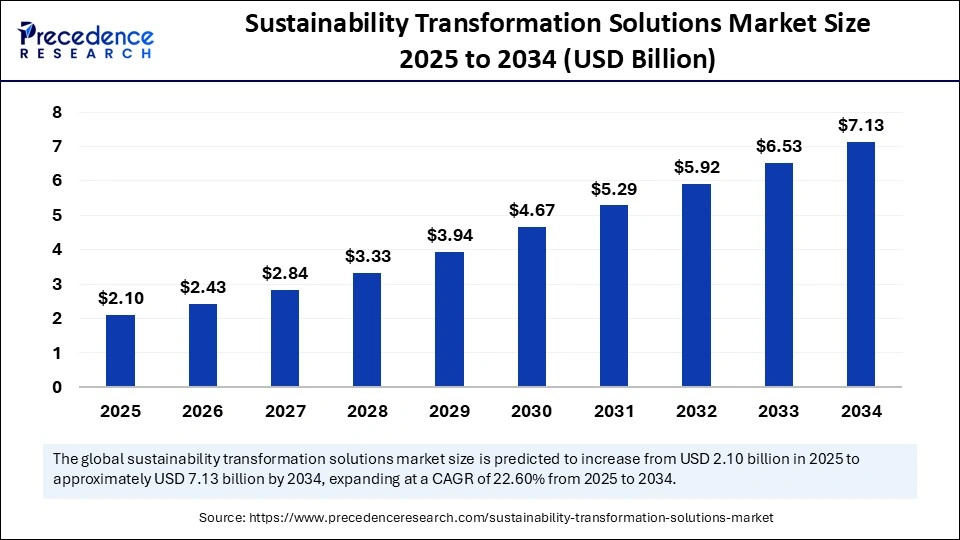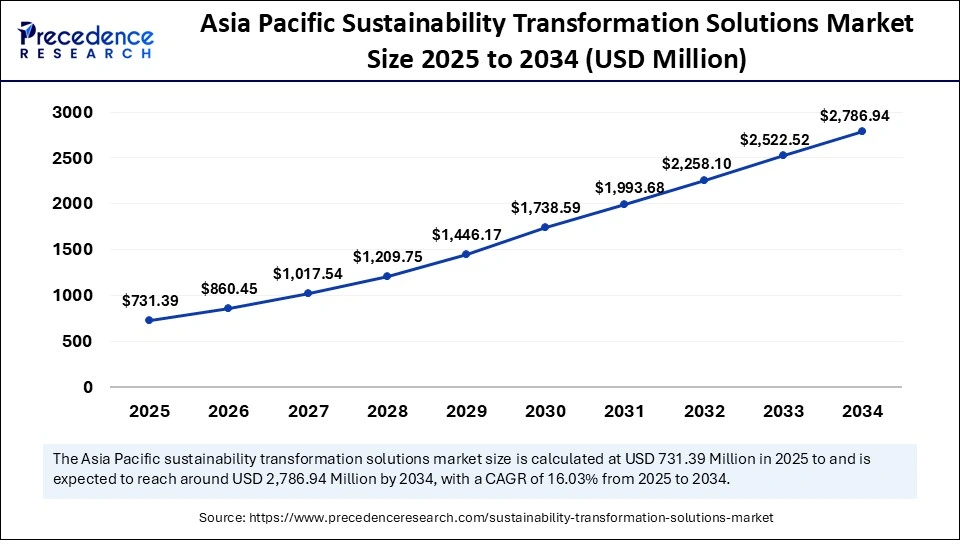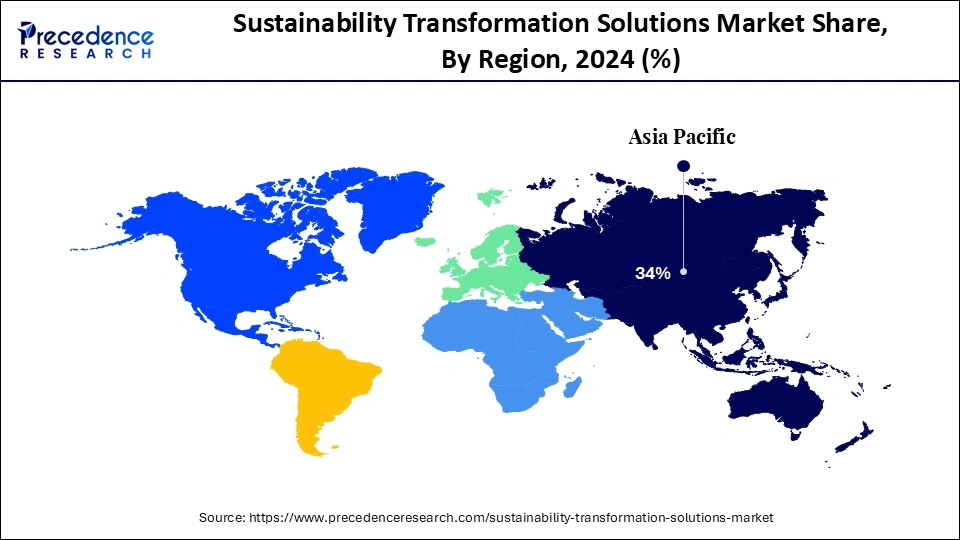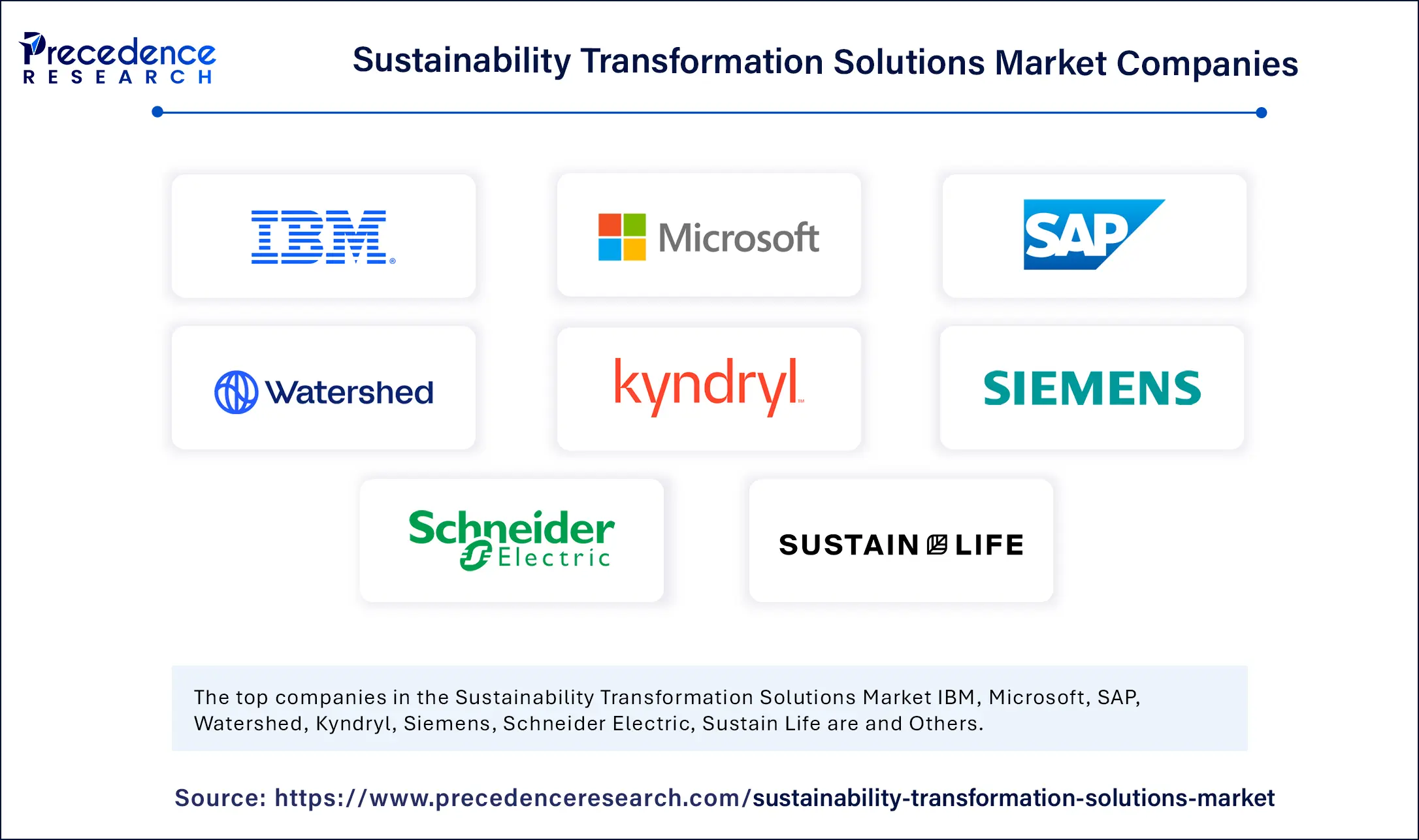List of Contents
Sustainability Transformation Solutions Market Size and Forecast 2025 to 2034
The global sustainability transformation solutions market size accounted for USD 1.82 billion in 2024 and is predicted to increase from USD 2.10 billion in 2025 to approximately USD 7.13 billion by 2034, expanding at a CAGR of 22.60% from 2025 to 2034. The growth of the market is driven by the increasing regulatory pressures, corporate ESG commitments, and rising demand for eco-friendly operations across industries.

Sustainability Transformation Solutions Market Key Takeaways
- Asia Pacific dominated the sustainability transformation solutions market with the largest revenue share in 2024.
- The Middle East & Africa are expected to grow at a notable rate.
- By solution type, the carbon optimization segment held the largest share of the market in 2024.
- By solution type, the carbon footprint segment is observed to grow at the fastest rate during the forecast period.
- By deployment model, the cloud-based segment dominated the market in 2024.
- By deployment model, the hybrid segment is expected to grow at the fastest rate in the coming years.
- By industry vertical, the renewables segment held the dominant share of the market in 2024.
- By industry vertical, the chemicals segment is expected to grow at the fastest rate during the forecast period.
How is AI Transforming the Sustainability Transformation Solutions?
Artificial Intelligence (AI) is significantly transforming sustainability transformation solutions by enabling data-driven decision-making, automating complex processes, and improving the accuracy of environmental impact assessments. Large amounts of historical and real-time environmental data, including supply chain footprint emissions and energy usage, are analyzed by AI-powered tools to find inefficiencies and suggest specific actions. AI is being used by sectors like manufacturing, energy, agriculture, and logistics to better forecast sustainability risks, minimize waste, and optimize resource usage.
In smart grids, for example, AI algorithms modify energy loads according to current demand, and machine learning models assist businesses in anticipating equipment failures and cutting down on energy waste. By examining buying trends and reducing overproduction, artificial intelligence makes sustainable inventory planning possible in retail and consumer goods. Additionally, by automating data collection and compliance with new international standards, AI improves ESG reporting.
Asia Pacific Sustainability Transformation Solutions Market Size and Growth 2025 to 2034
Asia Pacific sustainability transformation solutions market size was exhibited at USD 624.82 million in 2024 and is projected to be worth around USD 2,786.94 million by 2034, growing at a CAGR of 16.03% from 2025 to 2034.

What Factors Contribute to Asia Pacific's Dominance in the Market?
Asia Pacific dominated the sustainability transformation solutions market by capturing the largest share in 2024 due to increased corporate responsibility goals, stricter environmental regulations, and robust digital infrastructure. To meet investor expectations and sustainability goals, businesses in the region have embraced AI-driven optimization technologies, emissions-tracking platforms, and ESG reporting tools. The region's rapid industrialization and urbanization are contributing to the increased need for advanced sustainability transformation solutions. Furthermore, rising demand for renewable energy and the growing development of sustainable buildings ensure the long-term growth of the market within the region.

Singapore Sustainability Transformation Solutions Market Trends
Singapore is becoming a manufacturing hub for sustainability technology. To promote business transformation, the nation has implemented carbon pricing schemes, green finance guidelines, and ESG grants. Corporations are also supporting net zero goals by adopting low-emission buildings and sustainable data centers. Through the implementation of its Green Plan 2030, Singapore is incentivizing ESG integration and penalizes noncompliance, thereby encouraging companies to take swifter action.
India Sustainability Transformation Solutions Market Trends
India is witnessing rapid growth in the adoption of sustainability transformation solutions, driven by stringent environmental regulations and corporate sustainability goals. To achieve compliance and operational efficiency targets, businesses in the manufacturing, real estate, and energy sectors are embracing cloud-based carbon tracking, renewable energy monitoring, and ESG reporting tools. Affordable sustainability solutions are becoming more readily available thanks to startup-led innovations and digital public infrastructure. In addition, Indian businesses are increasingly adopting ESG reporting tools to develop sustainable supply chains.
Major Trends in the Sustainability Transformation Solutions Market Within the Middle East and Africa
The Middle East and Africa are expected to grow at a notable rate in the near future as businesses are prioritizing long-term environmental sustainability goals. National sustainability plans are being introduced by governments to incentivize businesses to use carbon tracking systems, water and waste optimization platforms, and smart building technologies. Increased foreign direct investment in green technology and infrastructure is another factor contributing to market growth. Growing concerns over climate change and regulatory pressure further support regional market growth.
Market Overview
The sustainability transformation solutions market is experiencing robust growth, driven by increasing adoption of these solutions across sectors increasingly prioritizing environmental responsibility, operational efficiency, and regulatory compliance. The global drive for net zero emissions and cutting-edge technologies like artificial intelligence, internet of things (IoT), anddata analytics drive organizations to embrace these solutions to align with ESG objectives and improve long-term value. Favorable government policies and a growing demand for transparent, quantifiable sustainability outcomes are driving the market's growth. These solutions are used in energy management, carbon tracking, and circular economy initiatives.
What Factors are Driving the Demand for Sustainability Transformation Solutions?
The demand for sustainability transformation solutions is being driven by regulatory pressure to reduce carbon emissions and the high demand for open ESG reporting. Organizations must use tools to monitor, control, and lessen their environmental impact as governments impose stringent climate-related regulations and carbon reduction goals. At the same time, businesses are under pressure from consumers, investors, and staff to show quantifiable progress toward sustainability objectives. Businesses are being pushed to invest in scalable and integrated sustainability solutions.
Sustainability Transformation Solutions MarketGrowth Factors
- Regulatory Compliance: Governments worldwide are enforcing stricter environmental regulations, pushing organizations to adopt sustainable practices and solutions.
- Corporate ESG Goals: Growing emphasis on environmental, social, and governance frameworks is prompting businesses to invest in sustainability transformation tools and services.
- Investor & stakeholder pressure: Investors and consumers increasingly favor companies with transparent sustainability metrics, encouraging enterprises to implement measurable green strategies.
- Cost savings through efficiency: Sustainability solutions help reduce energy consumption, waste, and operational costs, making them attractive from a financial standpoint.
- Brand Image & Competitive Advantage: Businesses using sustainability transformation as a differentiator gain consumer trust, boost brand loyalty, and outperform less eco-conscious competitors.
- Global Climate commitments: International agreements like the Paris Accord are influencing nations and corporations to pursue net zero carbon goals, driving market demand.
Market Scope
| Report Coverage | Details |
| Market Size by 2034 | USD 7.13 Billion |
| Market Size in 2025 | USD 2.10 Billion |
| Market Size in 2024 | USD 1.82 Billion |
| Market Growth Rate from 2025 to 2034 | CAGR of 22.60% |
| Dominating Region | Asia Pacific |
| Fastest Growing Region | Middle East & Africa |
| Base Year | 2024 |
| Forecast Period | 2025 to 2034 |
| Segments Covered | Solution Type, Deployment Model, Industry Vertical, and Region |
| Regions Covered | North America, Europe, Asia-Pacific, Latin America, and Middle East & Africa |
Market Dynamics
Drivers
Stringent Environmental Regulations
To fight climate change and lower carbon emissions, governments and regulatory agencies around the world are enforcing strict environmental laws, which drive the growth of the sustainability transformation solutions market. Manufacturing, energy, and logistics are among the industries that are being pressured to adhere to sustainability disclosures, reporting requirements, and emission caps. There may be penalties, legal action, or harm to one's reputation for not meeting these requirements. These regulatory environments are compelling businesses to implement sustainability transformation tools. These solutions facilitate reporting and automate compliance tracking. The expanding trend of required ESG disclosures further supports this momentum.
Need for Cost Optimization and Efficiency
Initiatives for sustainability frequently go hand in hand with cost reduction and operational effectiveness. The implementation of energy-efficient systems, waste reduction, logistics optimization, and material reuse can all result in significant cost savings. Solutions for sustainability transformation give businesses the means to find inefficiencies and monitor performance gains. Stronger margins and leaner operations are the results of these initiatives over time. Furthermore, waste reduction and energy conservation are both economically and environmentally responsible, resulting in long-term cost savings.
Restraints
Rising Cybersecurity & Data Privacy Risks
The amount of operational energy and supply chain data that sustainability platforms gather and analyze increases their vulnerability to cyberattacks. Businesses are more vulnerable to data breaches, illegal access, and compliance infractions like GDPR because technologies like AI and IoT increase the attack surface. This vulnerability causes hesitancy in the widespread adoption of cloud-based sustainability solutions, particularly among SMEs with weak cyber security infrastructure. Therefore, rising concerns over data privacy restraint the growth of the sustainability transformation solutions market.
Regulatory Overload & Conflicting Standards
Global standardization is advancing but many regulations are still being worked out such as the EU's corporate sustainability due diligence directive and CSRD. Companies are focusing on managing several reporting regimes at once because of the conflicting requirements created by different jurisdictions. The complexity of compliance deters smaller businesses from implementing sustainability transformation platforms. Moreover, integrating new systems can be complex, limiting their adoption and hindering the growth of the market.
Opportunities
AI-Driven Emissions Optimization
Advanced modeling and real-time monitoring made possible by AI, which are greatly lowering carbon footprints across industries. Using AI technologies in manufacturing can maximize energy loads, cut down on waste, and boost overall plant productivity. AI algorithms in the transportation sector assist businesses in reducing empty miles and planning the most fuel-efficient routes. Over time these tools lower operating costs while also advancing environmental goals. AI accuracy and scalability make it a vital component of strategies to reduce emissions.
Next-Gen Data Center Sustainability
There is pressure on data centers to continue being high-performance and low carbon as AI workloads spread around the world. Using renewable energy, AI-optimized cooling systems, and water-saving designs are all examples of sustainability transformation in this field. For effective scaling, businesses are implementing modular structures and retrofitting older buildings with green technologies. Additionally, these developments are helping data centers draw in ESG-conscious customers and meet Scope 2 emissions regulations.
Solution Type Insights
Why did the Carbon Optimization Segment Dominate the Sustainability Transformation Solutions Market?
The carbon optimization segment dominated the market with the largest share in 2024 as many businesses set their net-zero targets. Stringent emission reduction regulations imposed by governments boosted the adoption of carbon optimization solutions among businesses. Through these solutions, carbon-intensive operations can be optimized, and emissions from infrastructure fleets and facilities can be tracked in real time. Businesses rely on carbon optimization tools to make data-driven decisions that improve energy efficiency, streamline supply chains, and reduce waste. This segment's dominance is further supported by the global increase in carbon taxes and ESG disclosure requirements.
The carbon footprint segment is observed to grow at the fastest rate during the forecast period due to mounting demand for transparency throughout the product lifecycle from both regulatory agencies and consumers. When a product is manufactured, packaged, transported, used, and disposed of, these tools measure the emissions produced. PCF systems are being quickly integrated by retail FMCG and electronics brands to verify and convey their environmental claims as Scope 3 emissions become a key component of ESG audits and green labeling gains popularity.
Deployment Model Insights
What Made Cloud-based the Dominant Segment in the Market?
The cloud-based segment dominated the sustainability transformation solutions market with a major share in 2024 as businesses embraced platforms that are cost-effective, scalable, and agile to manage sustainability objectives. Cloud-based solutions enable real-time updates, multi-location access, and worldwide ESG reporting capabilities, all while integrating seamlessly with current enterprise systems. AI and analytics are also integrated into cloud platforms, which facilitates risk assessment of emissions tracking and compliance with changing sustainability standards. The trend toward digitization has cemented cloud computing as the standard deployment mode.
The hybrid segment is expected to grow at the fastest rate in the coming years as businesses are seeking flexibility and balance between scalability and data control. Hybrid solutions make it possible to process sensitive sustainability data locally while utilizing cloud-based intelligence for analytics and reporting, especially in areas with stringent data privacy regulations or in industries that are subject to regulations. Businesses are moving from legacy systems and want to digitize their sustainability strategies in a safe, phased manner without sacrificing performance or compliance, boosting the need for hybrid solutions.
Industry Vertical Insights
How does the Renewables Segment Dominate the Market?
The renewables segment dominated the sustainability transformation solutions market in 2024 due to the increased demand for solar, wind, and other renewable energy sources. Sustainability transformation solutions are increasingly integrated in the renewable energy industry to ensure sustainability standards are met. Solar, wind, and hydro power plants use advanced analytics, digital twins, and carbon tracking tools to guarantee optimal efficiency and regulatory compliance. Businesses can enhance grid integration, reduce downtime, and accurately report on clean energy generation with the aid of these solutions.
The chemicals segment is expected to grow at the fastest rate during the forecast period. The adoption of sustainability transformation solutions is rising in the chemical industry due to its complex supply chains and high emissions footprints. Chemical manufacturers are heavily investing in AI-driven carbon tracking, energy optimization, and sustainable sourcing platforms because of stringent emissions regulations and consumer demands for greener materials. To reduce environmental liabilities, transform operations, and stay competitive in global markets, businesses in this sector are now adopting sustainability solutions at a faster rate.
Sustainability Transformation Solutions MarketCompanies

Recent Developments
- In June 2025, Achilles released Comply 360, a sustainability and non-financial reporting platform that automates ESG data collection, reporting, project management, and alignment with emerging global frameworks.
(Source: https://www.esgtoday.com) - In June 2025, Microsoft released its annual environmental sustainability report, detailing progress against the 2020 sustainability targets, covering carbon, water, and waste impact, and outlining goals for the next fiscal year.
(Source: https://blogs.microsoft.com) - In May 2025, one of Asia's leading environmental and sustainability solution providers, Re Sustainability Ltd (ReSL), launched Integrated Sustainability Solutions (ISS). This solution is designed to help businesses embed sustainability across operations, infrastructure, and investment strategies.
(Source: https://government.economictimes.indiatimes.com)
Segments Covered in the Report
By Solution Type
- Carbon Tracking Solutions
- Reporting
- Product Carbon Footprint
- Carbon Optimization
- Sustainability Consulting
By Deployment Model
- On-premises
- Cloud-based
- Hybrid- Hybrid
By Industry Vertical
- Chemicals
- Mining & Metals
- Pharmaceuticals
- Manufacturing
- Smart cities
- Renewables
- Banking, Financial Services and Insurance (BFSI)
- Transportation & Logistics
- Government
- IT and Telecommunication
By Region
- North America
- Europe
- Asia Pacific
- Latin America
- Middle East & Africa
For inquiries regarding discounts, bulk purchases, or customization requests, please contact us at sales@precedenceresearch.com
Frequently Asked Questions
Ask For Sample
No cookie-cutter, only authentic analysis – take the 1st step to become a Precedence Research client